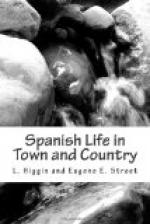It is most comforting; royalty, I feel sure, is nothing to it! We will not look critically at the lining of the noble barouche, nor at the varnish on its panels, still less make disagreeable remarks about the liveries, which do not always fit their wearers—it is economical to have liveries made a good medium size, so that if the servants are changed the clothes are not;—one can always feel grateful for the polite and agreeable attendants. How oddly it must strike the Spaniards in England to notice the stolid indifference of “Jeames de la Plush,” and the curt tap of his first finger on the brim of his hat as his lady enters her carriage or gives her directions!
All the mules, and most of the horses, ponies, or donkeys ridden by the “Jacket” men or country people are trained to pace instead of to trot; it is said to be less fatiguing on a long journey. The motion as you ride is, to our notions, very unpleasant, being a kind of roll, which at first, at any rate, gives one the feeling of sea-sickness. The animal uses the fore and hind feet together alternately, as he literally runs over the ground. It does not appear to be a natural pace, but is carefully taught, and, once acquired, it is very difficult to break the animal of it; his idea of trotting has become quite lost; nor is it a pretty action, nor one suited to show off good qualities—it has always something of a shuffle about it. If it has its advantages, except that stirrups may be dispensed with, they are not very apparent to those accustomed to the usual paces of an English horse. Personally, I disliked it particularly.
There have been many efforts to introduce racing, with its contingent improvement in the breed of horses, perhaps the earliest during the regency of Espartero; but these ended, as most things did in the old days when Spain was only beginning her long struggle for freedom, in failure and loss to the enterprising gentlemen—of whom the then Duque de Osuna was one—who spent large sums of money in the effort. The old race-course of that time lay somewhere in the low ground outside Madrid on the course of the Manzanares; many a good gallop I have had on it, though it was abandoned and forgotten long ago by the Madrilenos. At the present time horse-racing may be said to have become naturalised in Spain under the Sociedad del Fomento de la Cria Caballar (Society for the Encouragement of Horse-breeding), and all that concerns horsemanship is naturally improved and improving.
A good idea of Spanish horses may be gained by a visit to the Royal Mews in Madrid. There are the cream-coloured horses from the royal stud at Aranjuez, jacuitas from Andalucia, as well as the mountain ponies of Galicia. Those who have never seen the Spanish mule have no idea what the animal is—powerful, active, graceful, and almost impossible to injure. They are used in the royal stables and in those of the nobility, for night work, since they are so hardy




